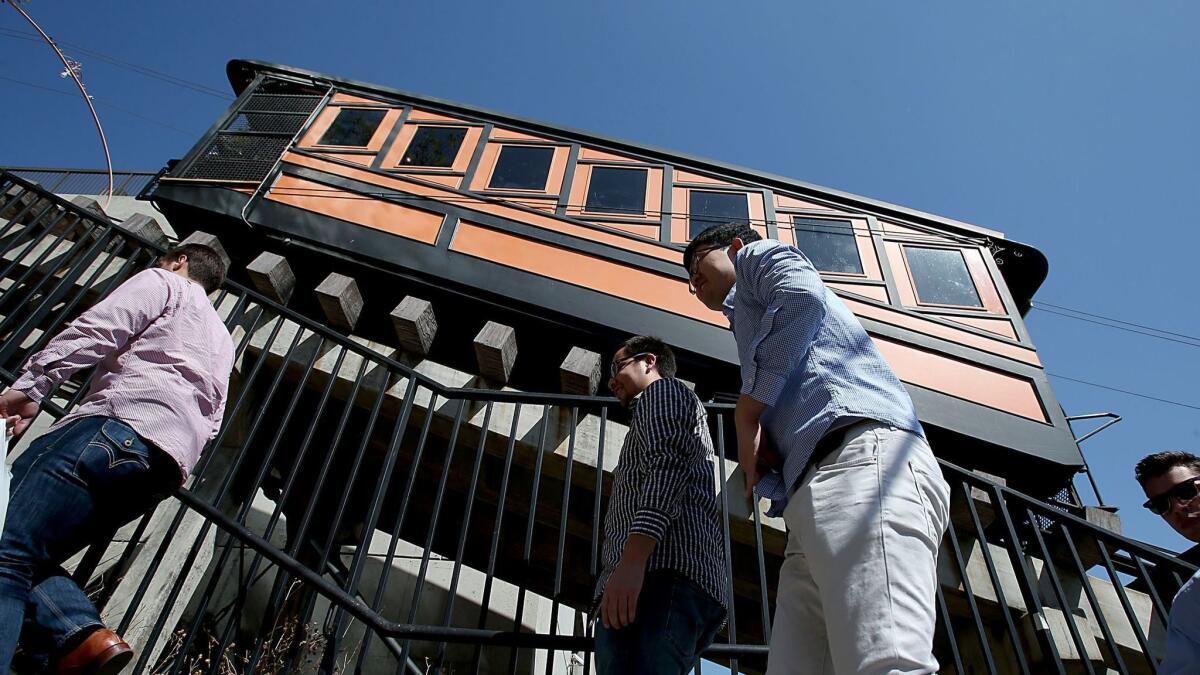Op-Ed: Only six more months until you can make L.A. history by riding Angels Flight

I have long been a fan of Angels Flight. No cynicism about downtown Los Angeles’ 298-foot-long funicular for me. Since its most recent closure in 2013, I’ve taken many a forlorn walk past its lower terminus on Hill Street, gazing longingly at its two cars, Sinai and Olivet, frozen in a tableau halfway up Bunker Hill.
Now, thanks to a deal between the Angels Flight Railway Foundation and the private transportation specialist ACS Infrastructure Development, Sinai and Olivet are scheduled to be back up and running by Labor Day — and I can’t wait.
What is it about the “shortest railway in the world”? Partly, I suppose, it’s the anomaly. Los Angeles is the last place you’d expect to find anything vintage that runs on rails. The city, after all, uprooted its extensive streetcar system by the early 1960s and is only rebuilding its transit network now.
Still, Angels Flight, which first opened in 1901, has persevered in its own peculiar fashion. The cars and station housings were put into storage in 1969 when Bunker Hill was flattened to build California Plaza, but the railway was resurrected in 1996, half a block south of its original location — a quintessential expression of Los Angeles history.
Originally a way for the elites who lived in mansions atop Bunker Hill to get to and from their offices, Angels Flight is no longer a transit necessity.
Angels Flight’s disappearance and its subsequent revival in a new place makes it kin to Chinatown, which was moved in the 1930s to make way for Union Station, and Olvera Street, which was reconstructed in the same decade as a tourist destination. And these aren’t the only Southern California landmarks that are in part contrivances, recreations. And yet, given the passage of the decades and the way the city has evolved, they make a claim, albeit an elusive one, on authenticity.
So does Angels Flight. Originally a way for the elites who lived in mansions atop Bunker Hill to get to and from their offices — and for their servants to get to and from the markets — Angels Flight is no longer a transit necessity. The city has survived without it, first in the years between 1969 and 1996, and then during two prolonged closures for safety reasons: the current one, since 2013, and another, from 2001 to 2010, after an accident killed an 83-year-old passenger.
At the same time, this unnecessary funicular is no mere amusement. In 2015, REDCAT Executive Director Mark Murphy said of it: “It’s so much fun to ride and has so much historical significance that we think of it as a novelty sometimes. … It’s actually an important economic link.”
REDCAT occupies the back side of Disney Hall and sits on the flattened top of Bunker Hill with the Broad Museum and MOCA and the Colburn School. As the city’s transit map continues to expand, Angels Flight, in conjunction with light rail and downtown’s regional connector, can play a small role. Without it, Bunker Hill is still a steep, sweaty climb from Broadway to Grand Avenue.
The other connections Angels Flights makes possible are just as important: to Los Angeles’ once and future heritage, its character as a city, its lived experiences for each of us.
When my son, Noah, was little — 3, 4 and 5 — we rode Angels Flight all the time. We would take the Purple Line downtown from Wilshire and Western, get off at Pershing Square, walk a block or so down Hill Street and ride the funicular up and down. Those excursions are part of what Angels Flight represents, at least to me.
In part, this is a matter of nostalgia, but it is also something more. Cities are built of memories as much as they are constructed out of steel and stone. When I walk by the orange arch on Hill Street, with its Beaux Arts flourishes, I recognize that Angels Flight remains a relic of the city as it was in 1901, but I’m mostly reminded of my own history in the place, all those Saturdays and Sundays with my son.
Back then, the two of us used Angels Flight as pure entertainment, and it often took us an entire afternoon to grow bored. We would ride, then watch the water dancing in the fountain at California Plaza, and afterward, we would ride a little more. That was a long time ago — my son is 22 now — and yet, when I read that Angels Flight would be reopening, the first thing I did was send him the link.
Come Labor Day, we’ll be in line to ride the shortest railway in the world again, to engage with a history that is collective and individual, that survives relocation, remodeling and even closure, and belongs both to Los Angeles and to us.
David L. Ulin is a contributing writer to Opinion.
Follow the Opinion section on Twitter @latimesopinionand Facebook
More to Read
A cure for the common opinion
Get thought-provoking perspectives with our weekly newsletter.
You may occasionally receive promotional content from the Los Angeles Times.











